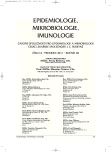Izolace Cronobacter spp. (dříve Enterobacter sakazakii) z nozder zdravého ustájeného koně – krátké sdělení
:
O. Holý 1; I. Matoušková 1; V. Holý 2; D. Koukalová 3; D. Chmelař 4
:
Department of Preventive Medicine, Faculty of Medicine and Dentistry, Palacký University, Olomouc, Czech Republic
1; Stud Farm Amona, Bolatice – Borová, Czech Republic
2; Department of Microbiology, Faculty of Medicine and Dentistry, Palacký University, Olomouc, Czech Republic
3; Institute of Microbiology and Immunology, Faculty of Medicine, University of Ostrava, Czech Republic
4
:
Epidemiol. Mikrobiol. Imunol. 60, 2011, č. 4, s. 167-169
Rod Cronobacter spp. patří do čeledi Enterobacteriaceae. Jedná se o pohyblivou (peritricha) gramnegativní bakterii, která netvoří spóry. V současnosti je Enterobacter sakazakii uváděn jako rod Cronobacter spp., který zahrnuje 16 bioskupin. Jedná se o ubikvitérní organismus, jehož izolace byla spojována s kontaminovanou sušenou počáteční kojeneckou výživou a nápoji pro novorozence a malé děti. Velmi omezené jsou informace o výskytu rodu Cronobacter spp. v životním prostředí, možném šíření a vektorech, které se mohou uplatňovat. Autoři sdělení prokázali výskyt Cronobacter spp. na sliznici nozder zdravého ustájeného koně. Tímto sdělením chtějí upozornit na zcela kusé a nesystematické informace o rozšíření kmene Cronobacter spp. v životním prostředí zvířat a lidí, kteří jsou s nimi v kontaktu.
Klíčová slova:
Cronobacter spp. (Enterobacter sakazakii) – počáteční sušená kojenecká výživa – vehikulum a rezervoár v životním prostředí
Sources
1. Iversen, C., Mullane, N., McCardell, B. et al. Cronobacter gen. nov., a new genus to accommodate the biogroups of Enterobacter sakazakii, and proposal of Cronobacterium sakazakii gen. nov., comb. nov., Cronobacter malonaticus sp. nov., Cronobacter turicensis sp. nov., Cronobacter muytjensii sp. nov., Cronobacter dublinensis sp. nov., Cronobacter genomospecies 1, and other three subspecies, Cronobacter dublinensis subsp. dublinensis subsp. nov., Cronobacter dublinensis subsp. lausannensis subsp. nov. and Cronobacter dublinensis subsp. lactaridi subsp. nov. Int. J. Syst. Evol Microbiol., 2008, 58, p. 1442–1447.
2. Farmer, J. J., III, Asbury, M. A., Hickman, F. W. et al. Enterobacter sakazakii: A new species of „Enterobacteriaceae“ isolated from clinical specimens. Int. J. Syst. Bacteriol., 1980, 30, p. 569–584.
3. Postupa, R., Aldová, E. Enterobacter sakazakii: A tween 80 estrase-positive representative of the genus Enterobacter isolated from powdered milk specimen. J. Hyg. Epidemiol. Microbiol. Immunol., 1984, 28, p. 435–440.
4. Matoušková, I., Janout, V., Pavlitová, M. Tabletový systém a možnost přenosu infekce (Tray system and its possibility for transmission of infection). Ed. Davidová, P., Rupeš, V., IV. konference DDD 2000, Přívozovy dny, Sborník referátů, s. 15–23.
5. International Commission on Microbiological Specification for Foods (ICMSF) (2002). Microbiological Testing in Food Safety Management (Vol. 7). New York: Academic/Plenum Publisher.
6. Hamilton, J. V., Lehane, M. J., Braig, H. R. Isolation of Enterobacter sakazakii from Midguts of Stomoxys calcitrans. Emerg. Infect. Dis., 2003, 9, p. 1355–1356.
7. Iversen, C., Lane, M., Forsyth, S. J. The growth profile, thermotolerance and biofilm formation of Enterobacter sakazakii growth in infant formula. Lett. Appl. Microbiol., 2004a, 38, p. 378–382.
8. CLSI (Clinical and Laboratory Standards Institute): performance standards for antimicrobial susceptibility testing, 19th informational supplement, M100-S19. Clinical and Laboratory Standards Institute, Wayne (PA, USA), 2009.
9. Abbott, S. 37. Klebsiella, Enterobacter, Citrobacter, Serratia, Plesiomonas, and Other Enterobacteriaceae. In Versalovic, J., Carroll, K. C., Funke, G. et al. Manual of Clinical Microbiology, 10th edition, ASM Press, 2011, p. 639–657.
10. Blažková, M., Fukal, L., Rauch, P. Nebezpečný patogen Enterobacter sakazakii a jeho detekce (Dangerous Pathogen Enterobacter sakazakii and its detection). Chem. listy, 2010, 104, s. 113–118.
Labels
Hygiene and epidemiology Medical virology Clinical microbiologyArticle was published in
Epidemiology, Microbiology, Immunology

2011 Issue 4
Most read in this issue
- Cases of Menstrual Toxic Shock Syndrome in the Czech Republic in 1997–2011
- Sixty Years of Research of Tick-borne Encephalitis – a Basis of the Current Knowledge of the Epidemiological Situation in Central Europe
- Isolation of Cronobacter spp. (formerly Enterobacter sakazakii) from Nostrils of Healthy Stable Horse – short communication
- The Occurrence of Microsporidial Infections and Toxoplasmosis in Slovak Women
